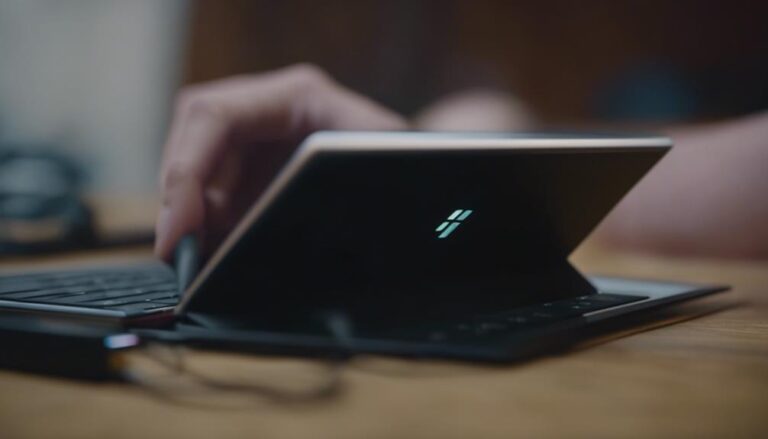Physical Address
304 North Cardinal St.
Dorchester Center, MA 02124
Physical Address
304 North Cardinal St.
Dorchester Center, MA 02124

Addressing a Microsoft Surface Pro that refuses to charge can be a frustrating ordeal, but fear not, solutions are within reach.
When faced with this issue, one must navigate through a series of troubleshooting steps to pinpoint the underlying cause.
From hardware checks to software tweaks, the path to a fully charged Surface Pro is paved with meticulous attention to detail.
Let's uncover the secrets to reviving your device's charging capabilities and restoring it to its full potential.
One of the common causes of Surface Pro not charging is power supply issues, which can lead to disruptions in the charging process. When the power supply is faulty, the charger may not deliver adequate power to the device, resulting in an inability to charge the battery. Additionally, damaged connectors, such as the USB port or charging port on the Surface device, can also impede the charging process. If the connectors are not properly seated or are dirty, a secure connection between the charger and the device may not be established, leading to charging issues.
Microsoft Surface Pro may also fail to charge if the power outlet or surge protector lacks power. In such cases, even if the charger is functioning correctly, the device will not charge due to insufficient power supply. Furthermore, battery settings on the Surface Pro, if misconfigured, could prevent the device from charging efficiently. Properly inspecting the power supply, ensuring a stable connection between the charger and device, and using different power sources when necessary can help troubleshoot and resolve common charging issues with the Microsoft Surface Pro.
To address charging issues with the Microsoft Surface Pro, it is essential to follow specific troubleshooting steps to identify and resolve any underlying issues efficiently.
Begin by checking the LED light on the power supply to determine the status of the charging connection. Inspect the power cable and connector for any visible damage that may be hindering the charging process.
Test the power supply with different outlets or power sources to rule out issues with the electricity source. It's also important to clean the charging port on the Surface Pro thoroughly to ensure there are no obstructions preventing a proper connection.
Restart the Surface Pro, run Windows updates, and reinstall the battery driver if necessary to troubleshoot any charging issues effectively. By following these steps systematically, you can pinpoint the root cause of the problem and take appropriate action to get your Surface Pro charging as intended.
When troubleshooting charging issues with the Microsoft Surface Pro, a crucial step is to thoroughly inspect the charging hardware and accessories for any signs of damage or malfunction. Start by checking the power supply of the charger and look for the LED indicator light to ensure it is receiving power. Inspect the USB port on the charger for any damage or debris that could hinder proper charging. Examine the charging cable for any bends, fraying, or visible damage that may impact its functionality. Additionally, scrutinize the charger connector that plugs into the Surface Pro device for any signs of damage.
If any issues are detected during the inspection, attempt to reset the power supply by following specific steps outlined by Microsoft to troubleshoot charging problems. Taking the time to thoroughly inspect and potentially reset the charging hardware and accessories can often resolve common charging issues with the Microsoft Surface Pro.
In troubleshooting charging issues with the Microsoft Surface Pro, software fixes play a crucial role in resolving potential issues affecting the device's charging functionality. To begin, ensure that all Windows updates are installed on your device as these updates often contain fixes for software-related charging issues. Additionally, it is advisable to check the battery driver in Device Manager and consider reinstalling it if any issues are detected that could be impacting the charging process.
If the problem persists, performing a factory reset on your Surface Pro could potentially resolve software-related charging problems. However, before proceeding with any software fixes, remember to back up your important data to prevent any loss during the troubleshooting process.
In cases where software fixes do not yield the desired results, it is recommended to seek professional repair services to diagnose and address the underlying cause of the charging issue effectively. By following these steps, you can address software-related charging issues on your Surface Pro efficiently.
Having addressed software fixes for Surface Pro charging issues, turning our attention to additional troubleshooting tips can further aid in resolving any persistent charging problems efficiently.
To revive a dead Surface Pro, perform a forced restart by holding the power button for 20 seconds, check the power supply LED for charging status, inspect the charging cable and port for damage, debris, or obstructions, and consider resetting the power supply and adjusting battery settings.
There are alternative methods to charge your Surface Pro. You can use a Surface Dock or different power sources like USB-C PD chargers. Ensure proper connection orientation and power supply compatibility. If issues persist, consider initiating a service order for professional assistance.
When a laptop is plugged in and not charging, potential causes could include a faulty power source, damaged charging cable, debris in the charging port, or driver issues. Troubleshooting steps may involve checking connections, inspecting hardware, and updating software.
To ensure your Surface Pro charges properly, secure the power connector, check for debris in the charging port, use the original charging cable, test the charger on another device, and reset the power supply if needed.
In conclusion, resolving Microsoft Surface Pro charging issues requires thorough troubleshooting of both hardware and software components. By following the steps outlined in this article, users can identify common causes of charging problems and take appropriate measures to address them.
Remember to check charging hardware, perform software fixes, and consider additional tips for resolving charging issues effectively. By following these steps, users can ensure their Surface Pro charges properly and functions as intended.